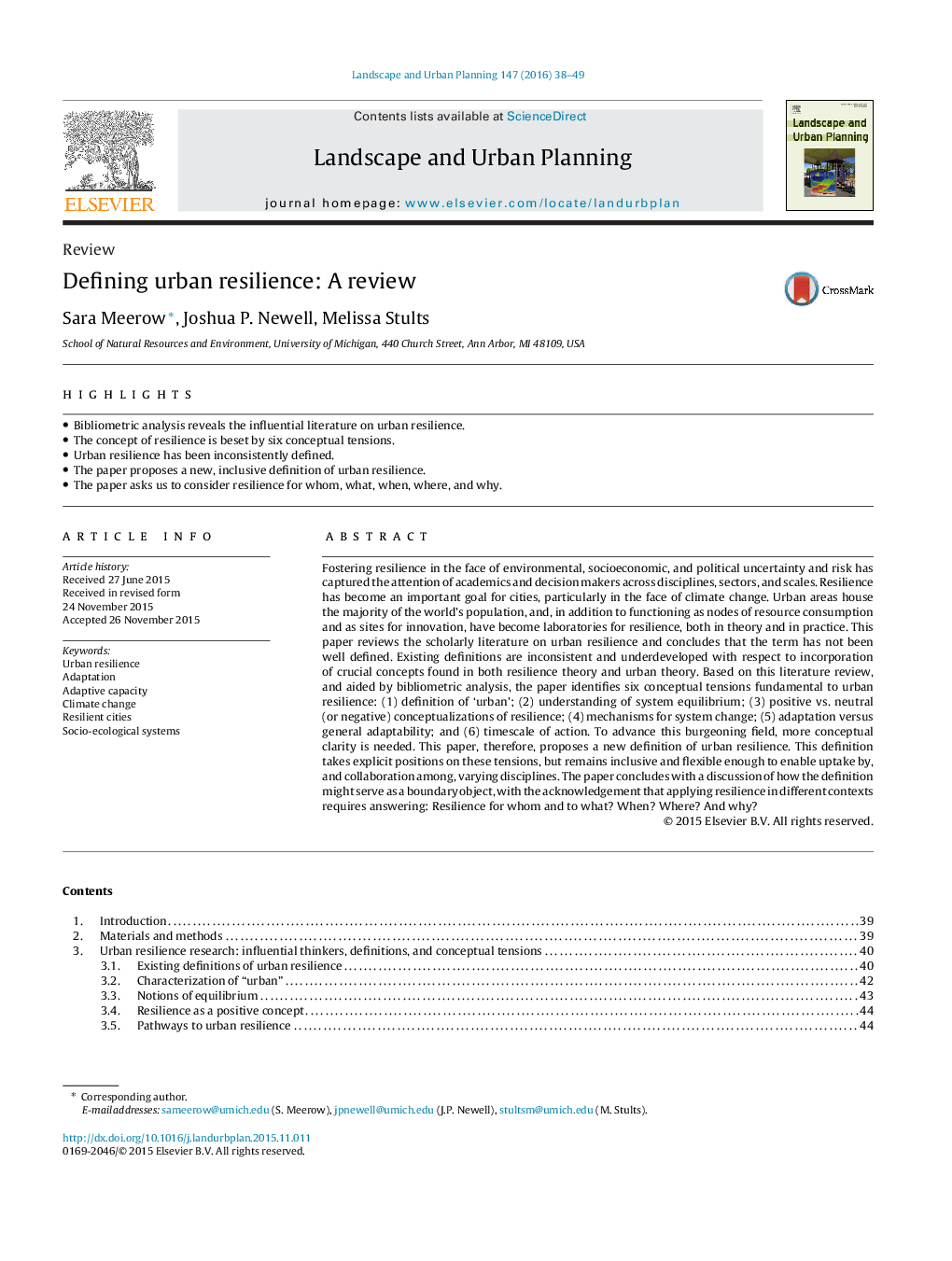| کد مقاله | کد نشریه | سال انتشار | مقاله انگلیسی | نسخه تمام متن |
|---|---|---|---|---|
| 7460803 | 1484611 | 2016 | 12 صفحه PDF | دانلود رایگان |
عنوان انگلیسی مقاله ISI
Defining urban resilience: A review
ترجمه فارسی عنوان
تعریف انعطاف پذیری شهری: بازبینی
دانلود مقاله + سفارش ترجمه
دانلود مقاله ISI انگلیسی
رایگان برای ایرانیان
کلمات کلیدی
انعطاف پذیری شهری، انطباق، ظرفیت سازگاری، تغییر آب و هوا، شهرهای مقاومتی سیستم های اجتماعی-محیطی،
ترجمه چکیده
تقویت انعطاف پذیری در مواجهه با عدم اطمینان زیست محیطی، اجتماعی و اقتصادی و سیاسی، توجه دانشگاهیان و تصمیم گیران را در رشته ها، بخش ها و مقیاس ها به تصویر کشیده است. انعطاف پذیری به اهداف مهم شهرها تبدیل شده است، به ویژه در مواجهه با تغییرات آب و هوایی. مناطق شهری اکثریت جمعیت جهان را تشکیل می دهند و علاوه بر کارکردن به عنوان گره های مصرف منابع و همچنین سایت هایی برای نوآوری، آزمایشگاه هایی برای انعطاف پذیری هستند، هم در نظریه و هم در عمل. در این مقاله، ادبیات علمی درباره انعطاف پذیری شهر بررسی شده و نتیجه می گیرد که اصطلاح به خوبی تعریف نشده است. تعاریف موجود در رابطه با ترکیب مفاهیم حیاتی که در هر دو تئوری انعطاف پذیری و تئوری شهری یافت می شوند، متناقض و نامناسب هستند. بر اساس این بررسی ادبیات و با کمک تجزیه و تحلیل کتابشناختی، مقاله شش مفهوم تنش اساسی برای انعطاف پذیری شهر را مشخص می کند: (1) تعریف "شهری"؛ (2) درک تعادل سیستم؛ (3) مفهوم سازی مثبت در برابر خنثی (یا منفی) انعطاف پذیری؛ (4) مکانیزم برای تغییر سیستم؛ (5) سازگاری در مقابل سازگاری عمومی؛ و (6) زمان عمل. برای پیش بردن این زمینه پرشور، وضوح مفهومی بیشتری لازم است. بنابراین، این مقاله، تعریف جدیدی از انعطاف پذیری شهر پیشنهاد می کند. این تعریف موقعیت های صریح را در این تنش ها می گیرد، اما به اندازه کافی فراگیر و انعطاف پذیر است تا امکان پذیری و همکاری میان رشته های مختلف را فراهم کند. مقاله با بحث درباره اینکه چگونه تعریف می تواند به عنوان یک جسم مرزی خدمت کند، نتیجه گیری می شود که استفاده از انعطاف پذیر در زمینه های مختلف نیاز به پاسخ دارد: انعطاف پذیری برای آنها و چه چیزی؟ چه زمانی؟ جایی که؟ و چرا؟
موضوعات مرتبط
علوم زیستی و بیوفناوری
علوم کشاورزی و بیولوژیک
بوم شناسی، تکامل، رفتار و سامانه شناسی
چکیده انگلیسی
Fostering resilience in the face of environmental, socioeconomic, and political uncertainty and risk has captured the attention of academics and decision makers across disciplines, sectors, and scales. Resilience has become an important goal for cities, particularly in the face of climate change. Urban areas house the majority of the world's population, and, in addition to functioning as nodes of resource consumption and as sites for innovation, have become laboratories for resilience, both in theory and in practice. This paper reviews the scholarly literature on urban resilience and concludes that the term has not been well defined. Existing definitions are inconsistent and underdeveloped with respect to incorporation of crucial concepts found in both resilience theory and urban theory. Based on this literature review, and aided by bibliometric analysis, the paper identifies six conceptual tensions fundamental to urban resilience: (1) definition of 'urban'; (2) understanding of system equilibrium; (3) positive vs. neutral (or negative) conceptualizations of resilience; (4) mechanisms for system change; (5) adaptation versus general adaptability; and (6) timescale of action. To advance this burgeoning field, more conceptual clarity is needed. This paper, therefore, proposes a new definition of urban resilience. This definition takes explicit positions on these tensions, but remains inclusive and flexible enough to enable uptake by, and collaboration among, varying disciplines. The paper concludes with a discussion of how the definition might serve as a boundary object, with the acknowledgement that applying resilience in different contexts requires answering: Resilience for whom and to what? When? Where? And why?
ناشر
Database: Elsevier - ScienceDirect (ساینس دایرکت)
Journal: Landscape and Urban Planning - Volume 147, March 2016, Pages 38-49
Journal: Landscape and Urban Planning - Volume 147, March 2016, Pages 38-49
نویسندگان
Sara Meerow, Joshua P. Newell, Melissa Stults,
